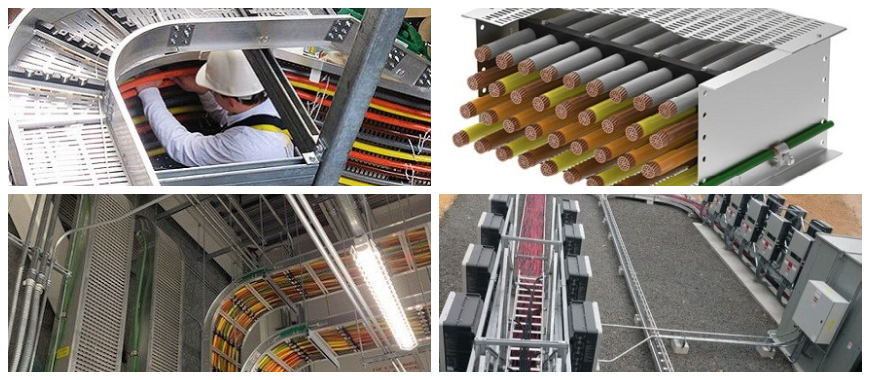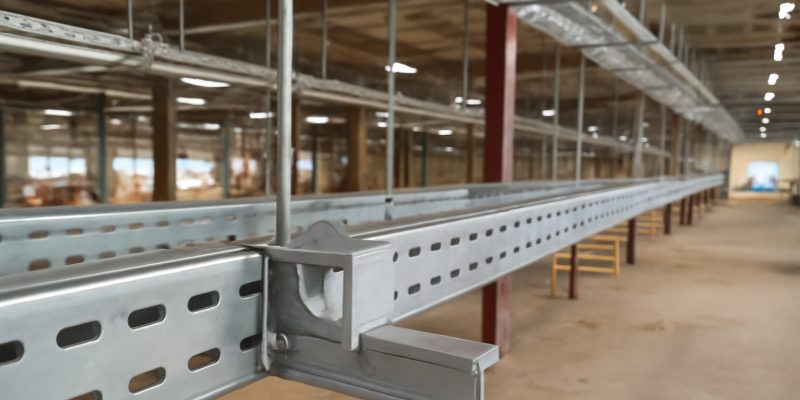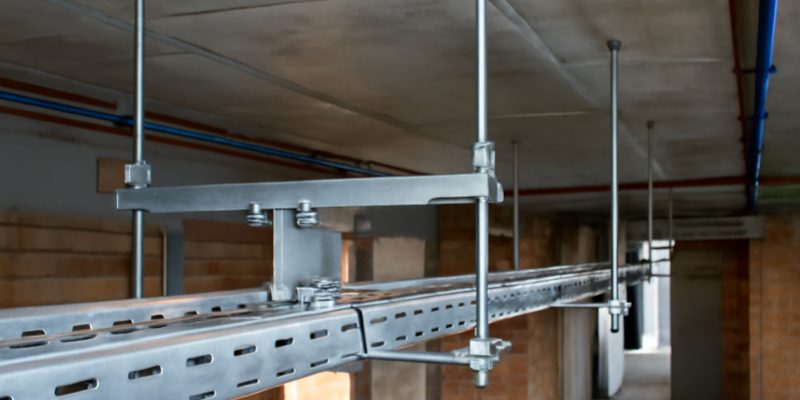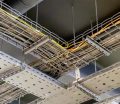
The cable tray expansion guide ensures safe longitudinal movement, with stainless steel clamps and aluminum I-beam design for industrial. Cable tray expansion guides are essential components in cable management systems. They help manage the thermal expansion and contraction of cable trays, ensuring the safety and efficiency of installations. As temperatures fluctuate, the materials in cable trays and reels expand and contract, which can lead to stress and potential damage if not properly managed. The cable tray expansion guide provides a controlled solution to this issue by allowing movement while maintaining stability. It ensures that the tray remains secure while accommodating the natural expansion and contraction of the materials. Proper use of expansion guides can prevent misalignment, improve system durability, and enhance overall safety in cable management systems.
What is a Cable Tray Expansion Guide and Its Benefits
A cable tray expansion guide is an essential component in industrial cable management systems. Its primary function is to accommodate the natural thermal expansion and contraction of the cable tray as temperatures change. When cables are routed through a tray, the material of the tray itself expands and contracts due to temperature fluctuations. Without proper management, this movement can cause misalignment, stress on cables, and potential damage to the entire system. A cable tray expansion guide allows for controlled movement, ensuring that the tray remains securely in place while providing enough flexibility to accommodate thermal changes.
Key Benefits of Using Cable Tray Expansion Guides
Cable tray expansion guides play a key role in enhancing the performance, safety, and longevity of electrical systems. These guides allow for controlled movement, managing thermal expansion, reducing wear, and preventing misalignment. Proper cable tray loading also ensures that the system operates efficiently. This ensures that the cable trays perform optimally, even in environments with extreme temperature fluctuations or heavy use, ultimately providing reliability and reducing the risk of damage or failure in the system.
Thermal Expansion Management
Expansion guides are designed to handle the thermal expansion and contraction of the cable tray, preventing misalignment and damage. They provide a controlled path for the system to expand and contract, maintaining structural integrity. By managing these temperature-induced movements, the guides minimize the risk of strain or wear on the trays and cables. This feature is especially important in environments with frequent temperature fluctuations, ensuring long-term reliability without costly repairs.
System Flexibility
Expansion guides offer the flexibility needed to allow for movement in both directions from a fixed point. This flexibility ensures that the cable tray system can adapt to changes in temperature, preventing undue strain on the components. By allowing controlled movement, the system can manage dynamic conditions more effectively, reducing the risk of damage from misalignment or overstress. This feature is vital in environments where temperature and load conditions change frequently.
Enhanced Durability
The use of expansion guides significantly enhances the durability of the entire cable tray system. They reduce wear and tear on the trays and cables by preventing thermal expansion from causing damage over time. Properly installed expansion guides ensure that the tray system remains functional for a longer period, minimizing the need for repairs or replacements. This durability is crucial for maintaining the integrity of the system in industrial or high-demand environments.
Improved Safety
Expansion guides contribute to improved safety by managing the thermal movement of the cable tray system. With proper thermal expansion management, the risk of system failure due to stress or misalignment is reduced. This decreases the likelihood of electrical hazards such as short circuits or fires. Maintaining alignment and preventing unnecessary strain on the system also reduces the risk of physical damage or accidents, ensuring a safer operating environment for both personnel and equipment.
Ease of Installation
Expansion guides are relatively simple to install, requiring minimal adjustments once placed at key points along the cable tray. This ease of installation helps reduce downtime during system setup. The guides are designed to be user-friendly, allowing for quick and efficient implementation with basic tools. Their straightforward installation process ensures that cable trays remain functional without causing significant delays in installation or maintenance procedures, benefiting businesses with smooth, uninterrupted operations.

Installation Guidelines for Cable Tray Expansion Guides
Proper installation of a cable tray expansion guide is critical to ensuring the longevity and performance of cable management systems. A well-installed expansion guide prevents unnecessary stress on trays, cables, and supports, while allowing for controlled movement due to thermal changes. By following industry standards, such as those outlined in NEMA VE-2, the system’s flexibility and stability are optimized. These guidelines help ensure that the cable tray functions efficiently, even in environments with fluctuating temperatures.
Proper Placement and Attachment
Proper placement and attachment of the cable tray expansion guides are crucial for ensuring that the system can function effectively. The guides should be installed on both sides of the tray to allow equal movement and should be attached to a fixed point for balanced thermal expansion. Securing the guides with bolts ensures they stay in place, providing stability and flexibility while preventing misalignment or damage caused by thermal changes.
Anchoring and Securing the Tray
Anchoring the cable tray at key points, particularly near expansion joints, ensures the system remains stable while still allowing for necessary movement. The tray should be anchored at the midpoint to balance the load and at other critical points to distribute weight evenly. Installing expansion guides at support locations prevents misalignment and keeps the tray in alignment during thermal expansion, reducing the risk of instability and ensuring smooth operation.
Ensuring System Resilience
To ensure the long-term performance and stability of the cable tray system, it is important to manage thermal expansion through proper installation. Using expansion guides and ensuring correct anchoring helps distribute the weight and movement of cables evenly, preventing strain and misalignment. These practices allow the system to function optimally, even in environments subject to temperature fluctuations, enhancing resilience and extending the lifespan of the cable tray system.
The Importance of Proper Installation and Maintenance
Proper installation and regular maintenance of the cable tray expansion guide are crucial for maximizing its effectiveness. If not correctly positioned or maintained, the expansion guide may fail to provide the necessary flexibility and support. This could lead to cable damage, tray misalignment, or even system failure. Regular inspection is essential to ensure the expansion guide is working as intended, and that no obstructions are preventing its movement. Paying attention to cable tray detail during installation helps ensure all components are correctly aligned and functioning.
Top Features of High-Quality PV Cable Trays for Solar
Types of Cable Tray Expansion Guides
Cable tray expansion guides come in various types, each offering specific benefits based on the environment and application. The right type of guide ensures optimal performance and durability in cable management systems. The most common types include steel cable tray expansion guides and snap track expansion plates. Each type serves a unique purpose, addressing different needs for expansion control, structural support, and ease of installation.
Steel Cable Tray Expansion Guide
Steel cable tray expansion guides are often the preferred choice for heavy-duty applications. These guides provide excellent durability and strength, which makes them ideal for environments where cables are subject to high stress and frequent movement. Here are the main benefits of using steel expansion guides:
- Durability and Strength: Steel expansion guides can withstand heavy loads and extreme conditions, offering long-term performance in industrial settings.
- Resistance to Wear: Steel is highly resistant to wear and tear, ensuring that the expansion guide continues to function without frequent replacements.
- High Temperature Resistance: Steel is less prone to damage from thermal fluctuations, making it suitable for high-temperature environments.
- Support in Heavy-Duty Environments: Steel expansion guides can support large, heavy cable trays, which are common in manufacturing and electrical plants.
Snap Track and Expansion Plates
Snap Track and expansion plates are alternative solutions used to manage thermal expansion in cable tray systems. These components offer a more flexible and cost-effective option for lighter-duty applications. Here’s how snap track and expansion plates are used:
- Easy Installation: Snap track can be easily secured to the tray using ¼” carriage bolts and nylon insert nuts, ensuring a stable connection.
- Adjustable Flexibility: Snap track allows for greater flexibility in accommodating different tray sizes and thermal expansion requirements.
- Cost-Effective Solution: Compared to steel guides, snap track and expansion plates are generally more affordable and simpler to install.
- Effective for Smaller Systems: These components work well in medium to light-duty cable tray installations, providing adequate expansion control without the need for heavy-duty materials.

Why Choose Waterproof Non-Metallic Cable Tray Systems
Key Accessories for Cable Tray Expansion Guide
In addition to the cable tray expansion guide, several key accessories are crucial for ensuring the optimal performance of cable tray systems. These accessories help provide additional support, stability, and flexibility, particularly when managing thermal expansion. Among the most important accessories are expansion guide clamps and hold down clamps. Cable tray blocks also play an essential role by providing structural support, ensuring the tray remains secure in place. Each plays a distinct role in ensuring that the tray remains secure and functional throughout its lifecycle.
Expansion Guide Clamp
The expansion guide clamp is an essential accessory for securing the cable tray expansion guide in place. These clamps help ensure that the expansion guide performs its role effectively by providing stability and support for the tray during thermal expansion, especially when used in conjunction with reels that manage the movement of cables. Here are the main benefits and functions of expansion guide clamps:
- Secure Tray Positioning: The expansion guide clamp ensures that the cable tray remains securely attached to the expansion guide, preventing any unwanted movement during thermal fluctuations.
- Accommodates Thermal Expansion: These clamps allow the cable tray to move freely within the expansion guide, accommodating both longitudinal and lateral thermal expansion without causing stress or damage.
- Improved Tray Stability: The expansion guide clamp maintains the tray’s stability while still permitting movement, reducing the risk of misalignment or tray failure due to excessive strain.
- Ease of Installation: The clamps are relatively easy to install and adjust, making the setup process faster and more efficient for large-scale installations.
Hold Down Clamps for Cable Tray
Hold down clamps serve a crucial role in maintaining the overall stability of cable tray systems. These clamps help prevent unwanted movement of the tray, especially in areas where there is significant thermal expansion or external forces, and are particularly effective when used in systems with reels that manage the cable movement. Here’s how hold down clamps contribute to the efficiency of cable tray systems:
- Prevents Tray Movement: Hold down clamps secure the cable tray to its mounting points, preventing it from shifting or dislodging during thermal expansion.
- Maintains System Alignment: These clamps keep the tray aligned with the expansion guide, ensuring that the system operates as intended without any misalignment or damage.
- Provides Additional Support: Hold down clamps provide extra support at various points along the tray, particularly in areas where there are large spans or heavy cable loads.
- Durable and Reliable: Made from high-strength materials, hold down clamps are designed to last under harsh conditions, ensuring long-term reliability in industrial applications.
Lightweight and Sturdy Round Cable Tray for Installation
Cable Tray Expansion Guide:Further Resources and References
At GangLong Fiberglass, we are committed to providing the best solutions for cable management systems. To help you make the most of our products, we offer various resources, including detailed PDF cut sheets and installation instructions for our cable tray expansion guides. These documents provide step-by-step guidance on how to effectively integrate our products into your systems.
Our cable tray expansion guide resources include:
Product Specifications
We offer PDF cut sheets that provide a detailed breakdown of the technical specifications for our cable tray expansion guides. These documents highlight essential information, including materials used, design features, and performance capabilities. You can access these specifications to ensure our products meet the exact requirements of your application. Whether you’re looking for specific load ratings, thermal expansion tolerances, or installation compatibility, our product specifications will give you the insight needed to make informed decisions.
Installation Instructions
We provide comprehensive installation guides to help you properly integrate our cable tray expansion guides into your systems. These step-by-step instructions are designed to ensure that you achieve optimal performance and system longevity. Each guide outlines the necessary steps, from proper placement and attachment of the guides to secure anchoring of the cable tray, with clear diagrams and detailed explanations. Following these instructions will help prevent common installation errors and ensure that your cable tray system operates efficiently under varying environmental conditions.
FAQs and Troubleshooting
In addition to detailed product specifications and installation guides, we offer a helpful FAQ section to address common questions and issues that may arise during installation or maintenance. Whether you’re dealing with alignment challenges, securing expansion guides, or understanding the best practices for system expansion, our FAQ section provides concise answers to help you navigate these obstacles. Additionally, our troubleshooting tips provide practical solutions to problems you may encounter, allowing for quick resolution and minimal disruption to your operations.
Technical Support Contact
If you need more personalized assistance, our customer support team is readily available to help. We provide a direct line to our technical support staff, who are equipped to assist you with any queries or concerns regarding our products. Whether it’s related to product specifications, installation, or troubleshooting, our team is here to provide prompt and expert guidance. This ensures that any issues you encounter during installation or maintenance are resolved quickly, helping you maintain the performance and reliability of your cable tray system.
By utilizing these resources, you can ensure that your cable tray system operates smoothly and efficiently. Proper cable tray measurement is a crucial part of this process, as accurate dimensions ensure that the system fits correctly and meets operational requirements. At GangLong Fiberglass, we strive to support our customers with the tools and information needed for successful installations and long-term system performance.

FAQs about Cable Tray Expansion Guide
The National Electrical Code (NEC) specifies guidelines for the maximum fill capacity of cable trays. According to NEC Article 392, the cable tray fill is based on the total cross-sectional area of the cables within the tray. For general installations, the tray should not be filled beyond 50% of its total internal cross-sectional area for cables larger than 2 inches. For cables smaller than 2 inches, the maximum fill is typically 40%. These guidelines help prevent overheating, ensure proper air circulation, and allow for future expansion of the tray. It’s also important to keep in mind that the fill percentage can vary depending on cable types, insulation material, and local regulations. When selecting a cable tray, it’s important to factor in these fill guidelines to ensure a safe and efficient system.
Cable trays need to be properly supported at regular intervals to maintain stability and prevent excessive sagging. The National Electrical Code (NEC) provides specific guidelines for the spacing of tray supports. For standard cable trays, the general recommendation is to support the tray every 5 feet. However, for heavier-duty trays or trays carrying large cables, supports may be required every 3 feet. The tray should also be anchored at its midpoint between expansion joints. It’s essential to use the correct support structure to avoid excessive stress on the tray and ensure long-term performance. For systems that handle significant weight or cable movement, it’s advisable to inspect the supports regularly and adjust as necessary. Proper support ensures the cable tray maintains alignment and can accommodate the thermal expansion and contraction that naturally occur in cable systems.
Calculating the correct size of a cable tray is essential for ensuring safe and efficient cable management. The first step is to determine the total cross-sectional area required for the cables being installed. This includes considering factors such as cable type, diameter, and insulation. Once the total area is calculated, it is important to check the cable tray’s specifications to ensure it offers adequate space without exceeding the fill limit set by the NEC. To avoid overcrowding, it’s recommended to allow some extra space for future expansion. Additionally, the tray’s size should account for the number of cables, their layout, and the type of environment. If cables are subject to frequent movement or thermal expansion, a larger tray size may be necessary. A cable tray expansion guide can help manage the movement of the tray, allowing it to expand and contract as needed while maintaining its structural integrity.
The spacing for cables within a cable tray is crucial for ensuring safe and efficient cable management. The NEC code outlines specific guidelines for spacing between cables based on the type of cable and tray. In general, cables should be spaced at least 1 inch apart to allow for proper ventilation and prevent overheating. For power cables and control cables, the spacing may need to be increased based on the cable diameter. Additionally, when cables are bundled together, their insulation type should be considered as it impacts heat dissipation. Spacing should also account for potential movement of the cables due to thermal expansion or environmental factors. For trays handling high-voltage cables, increased spacing is recommended to reduce the risk of short circuits or other electrical hazards. Proper cable spacing, combined with a cable tray expansion guide, helps maintain the integrity of the system over time.

As the editor of GangLong Fiberglass, I have years of experience and in-depth research, focusing on cable tray products, fiberglass solutions, and grille systems. I incorporate years of industry insights and practical experience into every content, committed to promoting the progress of the industry. At GangLong Fiberglass, my commitment is reflected in every product, from innovative cable trays to durable fiberglass solutions and sturdy grille systems. As an authoritative voice in the industry, my goal is to provide valuable information to professionals and businesses and promote forward-looking solutions.


